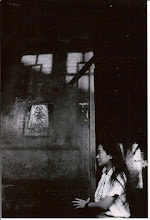

作品:The Blessed
材質:African Ebony(非洲黑檀)
臍帶之光:在火焰與慈悲之間的升誕
文:林若塵 10/14/2025
The Light of the Umbilical Cord: A Birth Between Flame and Compassion
By Ruochen Lin
從深色的木心中,一條縱向的生命敞開。這不是單純的形體雕刻,而是一條神學與美學同時被開出的脈絡:火焰、嬰孩、臍帶、母性——沿著一條不可逆的向上路徑,完成一次從煉痛到寧靜的過渡。
物質的聲音:黑檀的密語
黑檀的重量與微光,本身就帶有一種「慢性啟示」。相比於可被光速映照的白色大理石或輕盈木材,黑檀讓光線像慢慢被溶解的禮物,含蓄地滲入每一條刀刻纖維。TiAO在此選材已是敘事的一部:材質本身成為受難與祝福的媒介。
木紋在作品中並非被掩蓋,而是被呼喚;它的方向性、結疤、紋節,與雕刻刀的節奏相互糾纏,像一首在黑暗中誦讀的祈禱詩。這種物性語言強化了作品的縱向張力,讓觀者不只是看見意象,更能感受那由內而外、慢慢被啟動的上升力。
火焰:煉化而非毀滅
下方的火焰並非顯示毀滅性的災變。它以一種燃燒的孕育者之姿出現:吞噬舊形態,催促新形誕生。因此火在此成為一種淨化的節律——以痛換得透明,以灼燒換得光潔。這是一種帶有救贖意涵的熾烈,像宗教祭儀中的火焰,同時兼容基督奧秘的犧牲想像與佛教的淨化比喻。
嬰孩:被生出來的希望
中段的嬰孩不是被動的受造物;他的臉雖幼嫩,卻在被火焰、被臍帶、被母性的雙手同時環抱。嬰孩的雙手呈現祈禱與護持的混合姿勢:這是一種逆向的依賴——孩子向上被提昇,同時以祈使的姿態回向那上方的慈顏。
這個嬰孩象徵著「新生」的可能性:不是單純的起點,而是一種中性的存在,一個在痛與愛的張力中還未定型的靈性點。你在創作過程中反覆修改的痕跡,讓這個嬰孩的形態保留了生成的曖昧——更利於觀者投射自身的救贖記憶。
臍帶:流動的神學
那條臍帶是本作的樞紐。它既是生理的連結,也是神學的象徵——恩典與創傷的輸送管線。臍帶將下方的火焰、中段的嬰孩與上方的慈顏捆綁為同一個運動:它指出一條單向的流向(向上),卻在形象上顯示一種雙向的互惠(被牽引亦被回應)。
臍帶的線條若細而堅實,便成為「命脈」;若盤曲,它便說出歷史的傷痕。你曾思索可否使作品上下顛倒,那是一個關於恩典是否循環或單向的核心提問。最終保留不可顛倒的結構,賦予作品一種向上的救贖宣言,也保全了十字架式的縱向張力——苦難被指向救贖,而非無限循環。
上方的慈顏:平靜中的微笑
上方的臉帶着平靜且含著痛的微笑。這不是世俗的歡愉,而是穿越痛苦後的寂靜喜樂——既有基督的受難後成聖之態,也有菩薩以大悲觀照眾生的寬恕。面容的混融性,恰如TiAO在雕塑中所嘗試的跨宗教省思:聖母與菩薩在此不互相稀釋,反而彼此回響,成為一個更廣闊的「母性神秘」。
面容的微笑不是結束,而是一種完成——完成了從火焰到生命再到奉獻的路程。那微笑是一種可見的恩典,是雕塑最終的安置點,給予觀者一個可以停泊的視線。
手勢:互為的救贖
那雙手的接觸由一條臍帶牽引出,成為人與神、母親與孩子、受造與救贖之間的交會點。手勢同時屬於嬰孩與母性,模糊了身體界限,強化了互為救贖的觀念:被抱者也是抱者,被救贖者亦是救贖的起源。
在形式上,這種手勢打破了傳統母子造像的單向凝視,使得雕塑呈現一種相互回應的神聖動態:救贖不再是天賦的外來恩典,而是雙方互動中生成的共同事件。
可視化的神學:不可顛倒的信念
你曾思考顛倒擺放的可能,這想像具哲學和神學的誘惑力:若顛倒,恩典循環可被呈現為圓環;若不顛倒,則強調一次性、縱向的救贖。你選擇前者的放棄,是一種創作上的節制,也是一種神學立場:在《The Blessed》中,救贖由底部的煉痛向上流動,這條路徑雖允許回向,但在整體敘事上保留了「歷史的向度」。
結語:一道被祝福的傷口
《The Blessed》是以物質為語言的祈禱。你在黑檀上刻下的不是單一教義,而是一種跨宗教的靈性經驗:在火中誕生的嬰孩、由臍帶牽引的雙手、以及一張含痛而寧的慈顏,合寫成一首關於恩典、牽引與被提升的頌歌。
正如你自己所說,這件作品既非全由直覺成形,也並非一次完成;反覆的修正使得它保有多義性,並以更複雜的方式把觀者帶入一個生與死、給與受、循環與一次性的張力場中。
「Blessed is the wound through
which grace enters.」(蒙福的是那道讓恩典流進的傷口)
在這件木雕中,傷口不是終結,而是入口;從那入口,光向上流動,直到微笑成為最後一句祈禱。
The
Light of the Umbilical Cord: A Birth Between Flame and Compassion
By Ruochen Lin
Work: The Blessed
Material: African Ebony
From the dark heart of the wood, a
vertical life unfolds. This is not merely the carving of a form, but the
opening of a theological and aesthetic artery: flame, infant, umbilical cord,
and motherhood—moving along an irreversible upward path from purification
through pain to serenity.
The Voice
of Matter: The Whisper of Ebony
The weight and dim sheen of ebony
carry an inherent sense of slow revelation. Unlike marble or lighter woods that
yield quickly to light, ebony absorbs it, letting illumination seep in as if it
were a slow, dissolving gift. TiAO’s choice of material already tells part of
the story: the medium itself becomes the bearer of both suffering and blessing.
The grain of the wood is not hidden
but summoned. Its direction, knots, and fibers intertwine with the rhythm of
the carving tools, forming a prayer whispered in darkness. This material
language reinforces the work’s vertical tension, allowing the viewer not only
to see the imagery but to feel the inner force that presses upward from within.
The
Flame: Refinement, Not Destruction
The flames below are not signs of
annihilation but of purification. They appear as nurturing fire—devouring the
old form to bring forth the new. Fire here becomes a rhythm of cleansing: pain
transformed into transparency, burning into brilliance. It carries the dual
resonance of the Christian sacrifice and the Buddhist metaphor of purification.
The
Infant: Hope Born in Flame
The infant in the middle section is
not a passive creation. His face, tender yet luminous, is embraced
simultaneously by fire, by the umbilical cord, and by maternal hands. His
gesture—a fusion of prayer and protection—suggests a paradoxical dependence: the
child being lifted upward, yet also offering intercession toward the serene
face above.
The infant symbolizes the possibility
of new birth—not a beginning, but a neutral point of spiritual becoming,
suspended between agony and love. The traces of TiAO’s revisions give the form
a living ambiguity, inviting the viewer to project their own memory of
redemption.
The
Umbilical Cord: A Theology in Motion
The umbilical cord is the work’s axis.
Both physiological and theological, it channels the flow of grace and trauma.
It ties the flames, the infant, and the maternal face into one continuous
movement: directionally upward, yet visually reciprocal. Its firmness marks it
as a lifeline; its curvature, as the record of history’s wounds.
TiAO once considered making the
sculpture reversible—an idea charged with theological tension: is grace
circular or unidirectional? By keeping it upright, she preserves a declaration
of ascent, aligning the piece with the vertical tension of the Cross—where
suffering points toward redemption rather than endless recurrence.
The
Serene Face: A Smile Beyond Pain
The calm smile above is not of worldly
joy, but of serenity after transfiguration—part Christ after the Passion, part
Bodhisattva in boundless compassion. The fusion of faces achieves what TiAO
envisioned: a cross-religious tenderness, in which the Virgin and the
Bodhisattva do not dilute but echo one another, forming a wider mystery of
divine motherhood.
The smile marks completion: not an
ending, but fulfillment. It is the visible embodiment of grace—the final
resting point where the viewer’s gaze may find peace after the upward
pilgrimage from flame to form.
The
Gesture: Mutual Redemption
The touching hands, drawn together by
the umbilical cord, form the intersection of human and divine, mother and
child, creature and redeemer. The gesture belongs to both, dissolving bodily
boundaries and deepening the theology of reciprocity: the one who is held also
holds; the redeemed becomes the source of redemption.
Formally, this breaks away from the
traditional mother-and-child imagery of one-way compassion. Instead, it creates
a dynamic of sacred response—redemption as an event of mutual becoming, not as
a gift descending from on high.
Visual
Theology: The Faith of Irreversibility
TiAO’s abandoned idea of an invertible
sculpture carries philosophical weight: if inverted, grace would circulate
endlessly; kept upright, it affirms a single historical direction—salvation
flowing upward through pain. Choosing the latter is both artistic restraint and
theological stance: The Blessed becomes an ascent through history, a one-way
pilgrimage from fire to light.
Conclusion:
A Blessed Wound
The Blessed is a prayer written in matter.
TiAO carves not doctrine but experience: an interfaith spirituality where the
infant born of flame, the hands drawn by the umbilical cord, and the serene,
pain-bearing face unite in a hymn of grace, traction, and ascent.
As the artist herself said, this work
was not born purely of instinct but of repeated rethinking—each revision
deepening its polysemy, drawing the viewer into a field of tension between life
and death, giving and receiving, cycle and linear transcendence.
“Blessed is the wound through which
grace enters.”
In this sculpture, the wound is not an end but an entrance—through it, light
ascends, until the smile itself becomes the final prayer.

